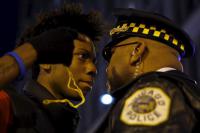-
White Nationalist groups growing much faster than ISIS on Twitter

The number of White Nationalists and self-identified Nazi sympathizers on Twiter had multiplied more than 600 percent in the last four years — outpacing ISIS in all social media aspects, from the number of follower counts to the number of daily tweets, a new study found. The study’s author notes that ISIS has gained a reputation for effectively using Twitter for propaganda and recruitment, but that White Nationalist groups have excelled even more in exploiting the medium. The report says that unlike the campaign Twitter has been conducting against ISIS, White Nationalists are continuing to use the service with “relative impunity.”
-
-
Europol deploys 200 counterterrorism officers to Greece to thwart ISIS infiltration
Rob Wainwright, the chief of Europol, the EU’s law enforcement agency, said that 200 counter terrorism officers will be deployed to the Greek islands within weeks in an effort to thwart a “strategic”-level campaign by ISIS to infiltrate terrorists into Europe. The new task force will be deployed alongside Greek border guards and use technologies developed by British security forces at Heathrow to help spot potential terrorists.
-
-
French schools to hold security drills, including mock terrorist attacks
As part of the French government’s bolstering of security measures in the wake of a series of terrorist attacks, French schools, beginning with the new school year, will now conduct three security drills a year – including at least one drill in which a mock assailants enter the school building.
-
-
Police seized drones trying to smuggle contraband into London prison
The police have seized two drones carrying drugs and mobile phones as they were making their way toward the all-male Pentonville jail in Islington, north London. Drones were increasingly being used to smuggle items into prisons in England and Wales. Figures showed there were thirty-three incidents involving devices in 2015, compared to two in 2014 and none in 2013.bDrugs, phones, mobile chargers, and USB cards were among the items discovered.
-
-
“Zombie drug” flakka causes “excited delirium,” but probably not cannibalism: Experts
It was a gruesome sight: Florida police pulled a 19-year-old Florida State University student away from the bodies of his two victims, only to find that the one of them was severely bitten in the face. Police officers say the immediately knew who (or, rather, what) the culprit was: flakka, or bath salts, a powerful man-made drug. Experts say that “bath salts” drugs can cause “excited delirium,” but probably do not drive users to cannibalism.
-
-
Data on taxi routes and points of interest could improve crime predictions

Data on how taxis travel through communities and on how people label points of interest on social media could help analysts and criminologists better understand neighborhood crime rates in a city. Analysis of data from points of interest in Chicago — including restaurants, shops, nightclubs, and transit stations — designated by members of FourSquare, a social media site, along with the city’s taxi flow information, offered significantly more accurate estimates of crime rates compared to traditional means. Crime analysts currently mainly rely on demographic and geographic data to study crime and predict trends.
-
-
Texas, UT ask judge to throw out lawsuit challenging campus carry
The Texas Attorney General’s Office and University of Texas at Austin on Monday asked a federal judge to throw out a lawsuit brought by three UT-Austin professors seeking to keep guns out of their classrooms despite the state’s new campus carry law. Three professors have argued that the law, which went into effect 1 August, will stifle discussion in their classrooms. The professors say they fear that guns present during class discussions will cause people to censor themselves out of concerns for their safety.
-
-
SayVU security app – developed by a BGU graduate student -- deployed at Rio Olympics

A new app, SayVU, conceived as a graduate student project at Ben-Gurion University of the Negev, is being deployed at the 2016 Rio Olympics. International Security & Defense Systems (ISDS), the security integrator for the Olympics, selected SayVU as one of the Israeli technologies being used to protect attendees. SayVU enables a user to send a distress signal to an emergency hotline even if a phone is locked and without having to access the application. The message can be sent in a number of ways; shaking the device, tapping the camera button, or simply speaking into the phone.
-
-
Mass shootings driven by "media contagion": Study
The prevalence of mass shootings has risen in relation to the mass media coverage of them and the proliferation of social media sites that tend to glorify the shooters and downplay the victims, a new study finds. “If the mass media and social media enthusiasts make a pact to no longer share, reproduce, or retweet the names, faces, detailed histories, or long-winded statements of killers, we could see a dramatic reduction in mass shootings in one to two years,” says one of the study’s authors.
-
-
Live-streaming crime incidents a challenge U.S. privacy law
In July, the fatal police shootings of Alton Sterling and Philando Castile went viral on social media. The aftermath of the Castile shooting was first shared via Facebook Live, which is a type of mobile streaming video technology (MSVT) that allows users to stream live video to followers, similar to Periscope and Meerkat. The two incidents focus attention on the legal rights of people to record and live stream and any potential right to be free from being recorded and streamed in public places.
-
-
600 armed police officers to protect London
The London police has launched Operation Hercules in which additional firearms officers will be deployed in visible roles in the capital. The Met will add 600 additional firearms officers to protect London against any attack. The first are now fully trained and operationally ready.
-
-
Public safety consolidation works well for some communities, but not for others
In the first comprehensive work of its kind, a Michigan State University criminologist has completed a study on the implementation and outcomes of public safety consolidation — the merging of a city’s police and fire departments. The study finds that while public safety consolidation can work well for some communities, it is not the best solution for others.
-
-
Reducing U.S. firearm suicide rates

In 2014, of the more than 33,500 firearm deaths in the United States, over 21,000 were the result of suicide. Studies in the United States showed that greater firearm availability is associated with greater risk of firearm suicide. Globally, four studies in other developed countries found that per capita gun ownership correlates with national firearm suicide rates. To reduce firearm suicide rates in the United States, the authors recommended several measures, such as targeted legislation to limit firearm access to individuals at risk for suicide, using smart gun technology, offering public education on firearm suicide, and research to evaluate the effectiveness of prevention methods.
-
-
Crime victims should call the police

As law enforcement agencies, community organizations, and public health officials work to develop effective crime-prevention strategies, new research finds that individuals who report being victims of crime to police are less likely to become future victims of crime than those who do not report their initial experiences.
-
-
U.S. police killed or injured more than 55,000 people during “legal interventions” in 2012

U.S. police killed or injured an estimated 55, 400 people during legal stop and search incidents and arrests in 2012, new research finds. Blacks, Native Americans, and Hispanics had higher stop/arrest rates per 10,000 of the population than Whites and Asians. And Blacks were by far the most likely to be stopped, and then arrested, the data show. “As the U.S. struggles to reduce citizen injuries during police contacts, it would seem prudent to train at-risk groups about appropriate behavior during police stops,” the researchers conclude.
-
More headlines
The long view
Why Was Pacific Northwest Home to So Many Serial Killers?
Ted Bundy, Gary Ridgway, George Russell, Israel Keyes, and Robert Lee Yates were serial killers who grew up in the Pacific Northwest in the shadow of smelters which spewed plumes of lead, arsenic, and cadmium into the air. As a young man, Charles Manson spent ten years at a nearby prison, where lead has seeped into the soil. The idea of a correlation between early exposure to lead and higher crime rates is not new. Fraser doesn’t explicitly support the lead-crime hypothesis, but in a nimble, haunting narrative, she argues that the connections between an unfettered pollution and violent crime warrant scrutiny.
